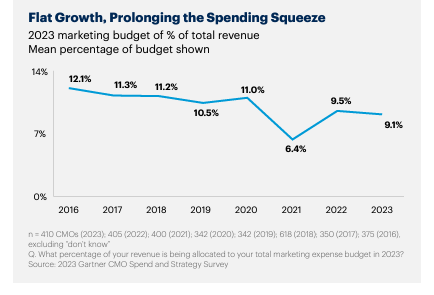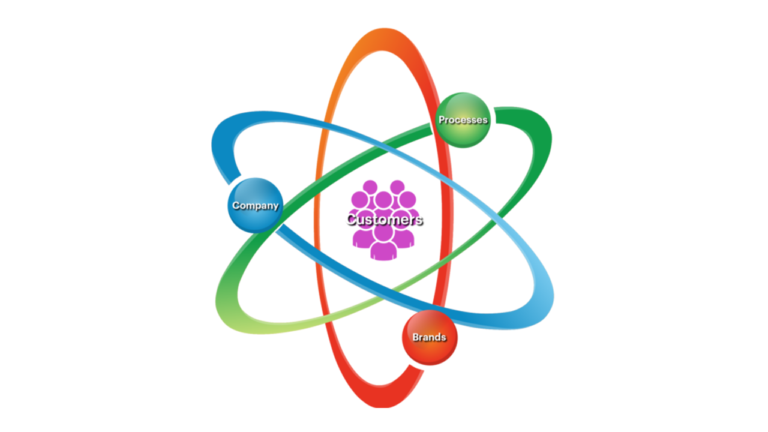As we all know and, unfortunately, have probably also experienced, every dollar in our marketing expenditure must be justified, and we have to prove our marketing ROI or risk budget cuts!
Chief Marketing Officers (CMOs) face the dual challenges of managing budget constraints while also demonstrating the return on investment (ROI) of their marketing initiatives.
The rapid evolution of today’s digital landscape only compounds these challenges, demanding strategic agility and an analytical mindset from today’s marketing leaders.
If you prefer to listen rather than read:
Marketing Budget Allocation
Gartner’s most recent (2023) CMO Spend Survey reported that marketing budgets fell from 9.5% of company revenue to 9.1% in 2023. This confirms the constant pressure on marketing to do more with less.
As a result, most have readjusted their commitments to marketing channels, resources, and programs, and a similar proportion say they are facing significant pressure to cut martech spending.
ROI on Marketing and Digital Specifically
The rule of thumb for marketing ROI is typically a 5:1 ratio, with exceptional ROI being considered at around a 10:1 ratio. Anything below a 2:1 ratio is considered not profitable, as the costs to produce and distribute goods/services often mean organizations will break even with their spend and returns.
However, according to a recent Data & Marketing Association (DMA) study, the average ROI for digital (email) marketing in 2022 was $36 for every $1 spent.
Of course, this figure varies by industry, with retail, e-commerce, and consumer goods companies often seeing higher returns thanks to direct purchase links in their emails.
While B2B companies have a slightly lower ROI, they benefit from the long-term value of relationship building and lead nurturing through email.
These numbers are a testament to the effectiveness of well-executed marketing strategies and the ROI of email. It’s clear that email marketing is thriving in the digital era.
A Strategic Approach to Navigating Budget Constraints
Reassess and Reprioritize Marketing Channels
In times of budgetary pressure, the first step for CMOs is to conduct a thorough reassessment of existing marketing channels. This involves analyzing each channel’s performance against key metrics to identify areas where spending can be optimized.
The goal is to allocate resources more effectively, focusing on high-performing channels that promise better engagement and conversion rates.
Embrace Cost-Effective Digital Marketing Strategies
Digital marketing offers a plethora of cost-effective strategies that CMOs can leverage.
Content marketing, email marketing, and social media platforms provide avenues for reaching large audiences at a fraction of the cost of traditional advertising.
By creating valuable content that resonates with their target audience, brands can foster engagement, build community, and drive conversions without hefty ad spending.
Foster Creativity and Innovation
It’s not all bad news! Budget constraints can actually serve as a catalyst for creativity and innovation within the marketing team.
Encouraging team members to think outside the box and develop unconventional ideas can lead to cost-effective marketing solutions that drive significant impact.
Whether it’s guerrilla marketing tactics, viral social media campaigns, or leveraging user-generated content, the key is to differentiate the brand in a crowded market without breaking the bank.
Winning Strategies for CMOs to Prove Marketing ROI
Prioritize Digital Channels: Digital channels continue to offer cost-effective opportunities to reach clearly identified target audiences. For example, content marketing and SEO can drive long-term traffic and leads at a lower cost than traditional advertising.
Leverage Customer Data: Using first-party customer data can help CMOs personalise marketing efforts, which will improve engagement and conversion rates without adding significant investments.
Optimize Ad Spend with AI: Artificial intelligence (AI) and machine learning can help optimize advertising campaigns in real-time, ensuring the budget is allocated to the most effective ads and channels.
Tracking Marketing ROI
Implement Advanced Analytics and Attribution Models
To accurately track marketing ROI, CMOs need to invest in advanced analytics tools and attribution models that can dissect the performance of each marketing effort.
Understanding the customer journey across touchpoints allows marketers to attribute conversions and revenue back to specific campaigns, clarifying what’s working and what’s not.
This was always a struggle until recent technology permitted the analysis of vast amounts of data from an ever-changing and increasingly complex customer path to purchase.
Set Clear, Measurable Objectives
For ROI tracking to be meaningful, marketing objectives must be clear and measurable. This means setting specific, time-bound goals for each campaign and establishing metrics and KPIs that align with broader business objectives.
By doing this, CMOs can ensure that marketing efforts are measurable and directly attributed to the company’s growth and profitability.
Foster a Culture of Data-Driven Decision Making
CMOs can no longer rely on creativity alone – if they ever did or should have in the past! Embracing a data-driven culture is imperative for CMOs aiming to track and improve marketing ROI today.
This involves collecting and analyzing data and ensuring that insights are developed to inform strategic decisions.
Training and encouraging the marketing team to use data analytics tools and interpret data will drive more informed, ROI-focused marketing strategies.
Enhancing Marketing ROI
According to a recent eMarketer study, marketers increasingly turn to multi-touch attribution models to better understand the customer journey and allocate spending more effectively across channels.
As previously mentioned, this is essential in an ever-more complex environment of purchase behaviour, with both online and offline channels playing important roles.
Here are some tactics that can be used to further enhance ROI tracking:
Implement Advanced Analytics Tools: Tools that provide detailed insights into customer behaviour and campaign performance can help CMOs identify which investments yield the highest returns.
Focus on Customer Lifetime Value (CLV): Calculating and prioritizing strategies based on CLV allows marketers to focus on long-term profitability rather than short-term gains. However, I admit this can sometimes be a challenge when a business is under threat.
Regular Reporting and Review: Establishing a routine for reviewing marketing metrics and ROI can help ensure that strategies remain aligned with overall business goals and the latest budget realities.
Real-World Success Stories
Walmart’s E-Commerce Strategy: As one of the largest retail chains globally, Walmart has made significant strides in its digital transformation by investing heavily in its e-commerce platform. This includes the acquisition of Jet.com for approximately $3 billion in 2016, and ongoing enhancements to its online presence and customer service capabilities. These efforts have helped Walmart to remain competitive against e-commerce giants like Amazon, showing a clear return on investment (ROI) through increased online sales and market share.
Nike’s Direct to Consumer (DTC) Approach: Nike has shifted its focus towards its Direct to Consumer (DTC) channel, reducing its dependence on wholesale distributors. This strategy involved enhancing its mobile applications, opening flagship stores, and improving the online shopping experience. As a result, Nike has seen a significant increase in digital sales, accounting for over 30% of its total revenues in recent fiscal years.
Salesforce’s Marketing Cloud: Salesforce, a leader in customer relationship management (CRM) software, has effectively used its Marketing Cloud platform to automate B2B marketing. Features like lead scoring, customer journey mapping, and automated workflows help businesses prioritize and engage with prospects efficiently. Salesforce’s clients have reported up to a 25% increase in marketing ROI and significantly higher conversion rates due to these automation tools.
Airbnb’s Use of Professional Photography: In its early stages, Airbnb encouraged hosts to improve their listing’s appeal by hiring professional photographers. This was part of a broader strategy to enhance user trust and satisfaction. This move significantly increased bookings; listings with professional photos tend to get 24% more reservations than those without. This was achieved with minimal marketing spend, focusing instead on improving the product’s intrinsic value.
Dell’s Advanced Analytics: Dell has implemented a sophisticated multi-touch attribution (MTA) model to analyze the effectiveness of various marketing channels. With this model, Dell identified that certain digital marketing strategies yielded higher returns than traditional advertising. Dell improved its overall marketing effectiveness and efficiency by reallocating resources towards these high-ROI activities.
Summarising The 5 Imperatives for Today’s CMOs
When facing the dual pressures of budget constraints and the imperative of demonstrating marketing’s ROI, CMOs must navigate a landscape marked by financial caution and strategic audacity. This delicate balancing act demands a keen understanding of the marketing dynamics and an innovative approach to resource allocation.
Strategic Reevaluation of Marketing Channels: In today’s digitally-driven market, reassessing the allocation of marketing budgets across various channels is crucial. CMOs should look beyond traditional mediums and consider emerging digital platforms where the audience engagement is measurably higher. Data analytics should drive these decisions, ensuring that every dollar spent can be accounted for in terms of audience reach and conversion rates.
Embracing Digital Opportunities: The digital transformation wave is no longer coming; it has arrived. CMOs must ride this wave by integrating advanced digital strategies such as personalized marketing through AI and machine learning, immersive customer experiences using AR and VR, and enhanced customer interaction through automated chatbots. These technologies are not just buzzwords but are proven drivers of customer engagement and satisfaction.
Fostering Creativity in Constraints: Constraints often lead to the most creative solutions. By encouraging a culture where innovation thrives—where ideas are freely shared and experimented with—CMOs can utilize creativity as a significant lever to achieve more with less. Initiatives like guerrilla marketing campaigns, viral social media posts, and influencer partnerships can generate substantial impact at a fraction of the cost of traditional marketing methods.
Adopting a Rigorous, Data-Driven Approach: In the age of big data, basing decisions on intuition alone is no longer sufficient. CMOs must cultivate a data-driven culture within their marketing teams. This involves not just the collection of data but also its thoughtful analysis through sophisticated tools to derive actionable insights. Utilizing metrics like customer acquisition cost (CAC), customer lifetime value (CLV), and marketing-originated customer percentage can help pinpoint the most lucrative initiatives.
Demonstrating Marketing Value: It is essential that CMOs communicate the outcomes of their marketing strategies effectively to other stakeholders in the business. By presenting clear and concise data that connect marketing efforts to tangible business outcomes, CMOs can underscore the critical role of marketing in driving the business forward. This transparency solidifies the position of the marketing department within the organization and aligns it more closely with the company’s strategic objectives.
In conclusion, as marketing landscapes evolve and budgets tighten, the role of the CMO has never been more challenging—or more critical to business success. I am sure you agree.
By strategically managing resources, embracing new technologies, fostering a creative work environment, and rigorously tracking and communicating ROI, CMOs can justify their budgets and assert their importance as pivotal contributors to the organization’s overarching goals.
In this complex equation, the blend of prudence and boldness will define the future trajectories of successful marketing leadership.
If you’re ready to enhance your marketing strategy with these strategies and tactics, don’t wait!









